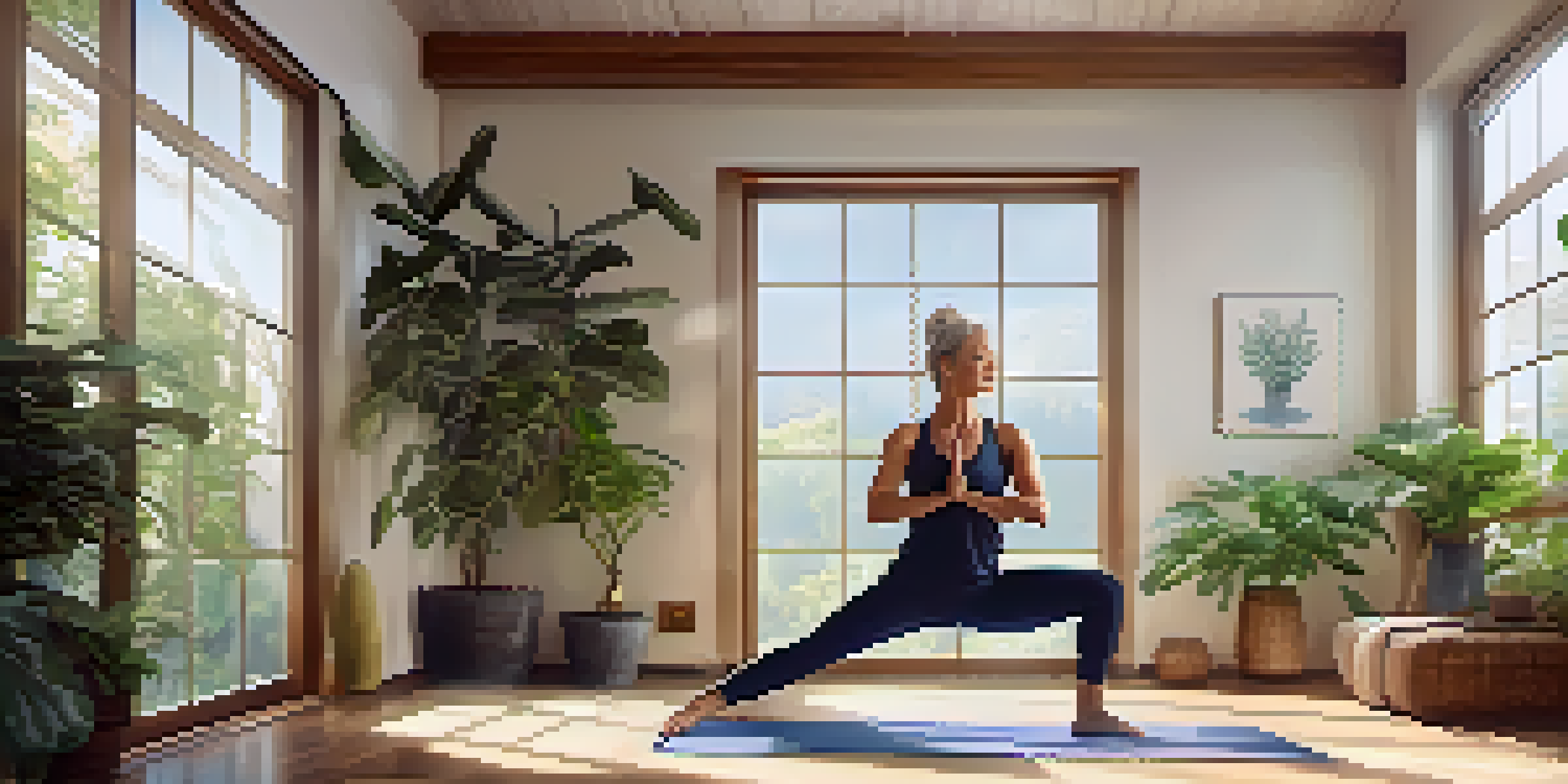Balancing Poses for Stability and Strength in Aging Parents

Understanding the Importance of Balance for Seniors
As we age, maintaining balance becomes increasingly vital. Good balance helps prevent falls, which are a leading cause of injury among older adults. It not only supports physical stability but also boosts confidence in day-to-day activities.
Balance is not something you find; it's something you create.
Engaging in balance exercises can significantly enhance muscle strength and coordination. This is crucial for seniors, as these elements contribute to overall mobility and independence. When seniors feel stable, they’re more likely to participate in social and physical activities.
Incorporating balance training into their routine can lead to a happier, healthier lifestyle. It fosters a sense of accomplishment and can even improve mental well-being. Ultimately, understanding the importance of balance is the first step towards a more active and fulfilling life.
Simple Balancing Poses to Try at Home
There are several effective balancing poses that can be done at home without any special equipment. One such pose is the Tree Pose, where one stands on one leg while placing the other foot on the inner thigh or calf of the standing leg. This pose not only improves balance but also strengthens the legs and core.

Another great option is the Heel-to-Toe Walk. This exercise involves walking in a straight line, placing the heel of one foot directly in front of the toes of the other. It may seem simple, but it challenges coordination and stability, making it an excellent addition to a daily routine.
Balance is Key for Seniors' Safety
Maintaining good balance helps prevent falls, which are a leading cause of injury among older adults.
Lastly, the Chair Pose is a wonderful way to engage the lower body while improving balance. Standing with feet hip-width apart, lowering down as if sitting in an invisible chair helps strengthen the legs and core, creating a solid foundation for overall stability.
Creating a Safe Environment for Practice
Safety is paramount when practicing balancing poses, especially for aging parents. Ensure that the practice area is clear of clutter and has enough space to move around freely. Soft surfaces like yoga mats can provide additional grip and comfort.
The key to success is to start before you are ready.
Using sturdy furniture for support can also enhance safety during balance exercises. Encourage them to hold onto a chair or countertop while practicing poses, gradually reducing reliance on these supports as they gain confidence and strength.
Finally, consider practicing near a wall or in a space where help is readily available. This precaution allows them to explore their limits without the fear of falling, fostering a more enjoyable and stress-free experience.
Incorporating Balance Training into Daily Routines
To reap the benefits of balance training, it's essential to integrate these exercises into daily routines. This could mean dedicating just a few minutes each day to practicing poses or including them in existing activities, like stretching or yoga.
Encourage aging parents to set aside a specific time for balance practice, turning it into a family activity. Involving loved ones can provide motivation and make the process enjoyable, ensuring they stay engaged and committed.
Simple Exercises Boost Stability
Incorporating simple balancing poses like Tree Pose and Heel-to-Toe Walk into daily routines can significantly improve strength and coordination.
Consistency is key, so remind them to be patient and celebrate small victories. Over time, they'll notice improvements in their stability, strength, and overall confidence in their movements.
The Role of Mindfulness in Balance Exercises
Mindfulness plays a crucial role in balance exercises, as it encourages focus and awareness of body movements. Practicing mindfulness can enhance the connection between mind and body, leading to better control and stability during poses.
Encourage aging parents to take a moment to breathe deeply before starting their exercises. This mindfulness practice can help center their thoughts and prepare them for the physical activity ahead, fostering a more intentional approach.
Incorporating mindfulness into balance training not only improves performance but also makes the experience more enjoyable. It can transform exercise from a chore into a meditative practice, promoting overall well-being.
Tracking Progress: Celebrating Small Wins
Tracking progress is an excellent way to stay motivated and see improvements in balance and strength. Encourage aging parents to keep a journal where they can note their daily practice and any milestones they achieve, no matter how small.
For instance, if they manage to hold a balancing pose for a few more seconds than before, that’s a win worth celebrating! Recognizing these achievements helps reinforce their commitment to balance training and boosts their confidence.
Mindfulness Enhances Balance Training
Practicing mindfulness before balance exercises promotes focus and awareness, leading to better control and enjoyment during the activity.
Additionally, sharing progress with family or friends can create a support network. This encouragement can inspire them to continue their practice and enjoy the journey of improving their stability and strength.
When to Seek Professional Guidance
While practicing at home is beneficial, there may be times when professional guidance is necessary. If aging parents experience significant difficulty with balancing poses or have a history of falls, consulting a physical therapist or a qualified instructor can provide personalized support.
These professionals can assess their abilities and create tailored exercise plans that address specific needs. They can also ensure that exercises are performed safely and effectively, minimizing the risk of injury.

Ultimately, seeking professional guidance can be a crucial step in enhancing balance and overall physical health. It is an investment in their well-being that can lead to improved strength, stability, and confidence.